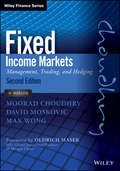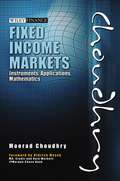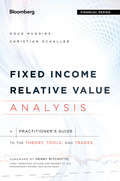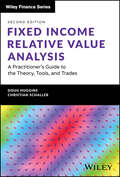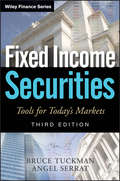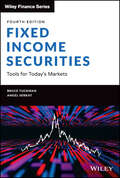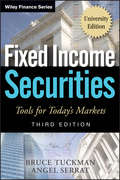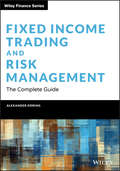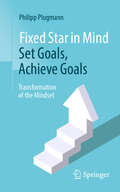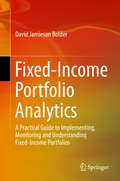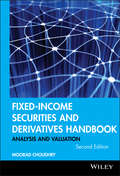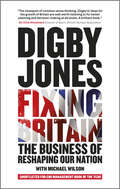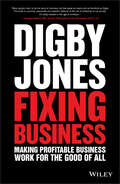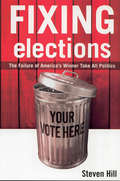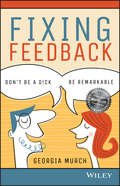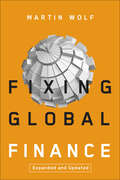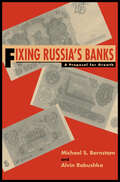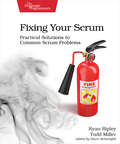- Table View
- List View
Fixed Income Markets
by Moorad Choudhry David Moskovic Max WongA comprehensive, in-depth look at global debt capital markets in the post-crisis worldFully updated with comprehensive coverage of the post-crisis debt markets and their impact on key industry issues, Fixed Income Markets: Management, Trading, and Hedging, Second Edition offers insights into derivative pricing, cross-currency hedging, and new liquidity legislation. Written by Choudhry, Moskovic, and Wong, Fixed Income Markets is an indispensable read for anyone working in bond markets, interest-rate markets, and credit derivatives markets looking to better understand today's debt markets.This acclaimed book takes a unique look into the leading practices in bond markets as well as post-credit-crunch impacts on pricing that are rarely captured in textbooks. The new edition provides expanded coverage on a wide range of topics within hedging, derivatives, bonds, rebalancing, and global debt capital markets. New topics include:Dynamic hedging practices and cross-currency hedgingCollateralized and uncollateralized derivatives, and their impact on valuationCallable bonds, pricing, trading, and regulatory aspects related to liquidityRebalancing as a method for capturing contingencies and other complex imbedded risksAs a bonus, the book includes reference information for statistical concepts and fixed income pricing, as well as a full glossary and index. Written in Choudhry's usual accessible style, Fixed Income Markets is a comprehensive and in-depth account of the global debt capital markets in today's post-crisis world.
Fixed Income Markets
by Moorad ChoudhryThis book is a comprehensive and in-depth account of the global debt capital markets. It covers a wide range of instruments and their applications, including derivative instruments. Highlights of the book include: Detailed description of the main products in use in the fixed income markets today, including analysis and valuation Summary of market conventions and trading practices Extensive coverage of associated derivatives including futures, swaps, options and credit derivatives Writing style aimed at a worldwide target audience An overview of trading and investment strategy. The contents will be invaluable reading for anyone with an interest in debt capital markets, especially investors, traders, bond salespersons, risk managers and banking consultants.
Fixed Income Relative Value Analysis
by Christian Schaller Doug HugginsAs western governments issue increasing amounts of debt, the fixed income markets have never been more important. Yet the methods for analyzing these markets have failed to keep pace with recent developments, including the deterioration in the credit quality of many sovereign issuers. In Fixed Income Relative Value Analysis, Doug Huggins and Christian Schaller address this gap with a set of analytic tools for assessing value in the markets for government bonds, interest rate swaps, and related basis swaps, as well as associated futures and options.Taking a practitioner's point of view, the book presents the theory behind market analysis in connection with tools for finding and expressing trade ideas. The extensive use of actual market examples illustrates the ways these analytic tools can be applied in practice.The book covers:Statistical models for quantitative market analysis, in particular mean reversion models and principal component analysis.An in-depth approach to understanding swap spreads in theory and in practice.A comprehensive discussion of the various basis swaps and their combinations.The incorporation of credit default swaps in yield curve analysis.A classification of option trades, with appropriate analysis tools for each category.Fitted curve techniques for identifying relative value among different bonds.A multi-factor delivery option model for bond future contracts.Fixed Income Relative Value Analysis provides an insightful presentation of the relevant statistical and financial theories, a detailed set of statistical and financial tools derived from these theories, and a multitude of actual trades resulting from the application of these tools to the fixed income markets. As such, it's an indispensable guide for relative value analysts, relative value traders, and portfolio managers for whom security selection and hedging are part of the investment process.
Fixed Income Relative Value Analysis + Website: A Practitioner's Guide to the Theory, Tools, and Trades (The Wiley Finance Series)
by Christian Schaller Doug HugginsAn invaluable guide for fixed income practitioners, fully updated to incorporate the shift from LIBOR to SOFR Since its first edition in 2013, Fixed Income Relative Value Analysis: A Practitioner’s Guide to the Theory, Tools, and Trades has become the gold standard for guides linking financial theories with practical analysis tools. The newly revised second edition reflects both the progress in statistical tools over the last decade and the impact of the transition to SOFR on swap spreads. You’ll find a set of statistical and financial tools, a multitude of actual trades resulting from the application of these tools, as well as access to a companion website featuring spreadsheets illustrating some of the models contained in the book. This book covers: Statistical models for quantitative market analysis, in particular mean reversion models and principal component analysis, now including the multivariate Ornstein-Uhlenbeck model. An in-depth approach to understanding swap spreads in theory and practice. A comprehensive discussion of the various basis swaps and their combinations. The incorporation of credit default swaps in yield curve analysis. A classification of option trades into three types and the appropriate analysis tools. Fitted curve techniques for identifying relative value among different bonds. A multi-factor delivery option model for bond future contracts.Fixed Income Relative Value Analysis has proven to be an indispensable desk reference for buy- and sell-side fixed income professionals, including traders, quantitative analysts, portfolio managers, financial engineers, fixed income salespeople with sophisticated clientele and risk managers.
Fixed Income Securities
by Bruce Tuckman Angel SerratFixed income practitioners need to understand the conceptual frameworks of their field; to master its quantitative tool-kit; and to be well-versed in its cash-flow and pricing conventions. Fixed Income Securities, Third Edition by Bruce Tuckman and Angel Serrat is designed to balance these three objectives. The book presents theory without unnecessary abstraction; quantitative techniques with a minimum of mathematics; and conventions at a useful level of detail. The book begins with an overview of global fixed income markets and continues with the fundamentals, namely, arbitrage pricing, interest rates, risk metrics, and term structure models to price contingent claims. Subsequent chapters cover individual markets and securities: repo, rate and bond forwards and futures, interest rate and basis swaps, credit markets, fixed income options, and mortgage-backed-securities. Fixed Income Securities, Third Edition is full of examples, applications, and case studies. Practically every quantitative concept is illustrated through real market data. This practice-oriented approach makes the book particularly useful for the working professional. This third edition is a considerable revision and expansion of the second. Most examples have been updated. The chapters on fixed income options and mortgage-backed securities have been considerably expanded to include a broader range of securities and valuation methodologies. Also, three new chapters have been added: the global overview of fixed income markets; a chapter on corporate bonds and credit default swaps; and a chapter on discounting with bases, which is the foundation for the relatively recent practice of discounting swap cash flows with curves based on money market rates. [FOR THE UNIVERSITY EDITION] This university edition includes problems which students can use to test and enhance their understanding of the text.
Fixed Income Securities: Tools for Today's Markets (Wiley Finance #621)
by Bruce Tuckman Angel SerratBuild or brush up on the foundation you need to be a sophisticated fixed income professional with this proven book Fixed Income Securities: Tools for Today&’s Markets has been a valued resource for practitioners and students for over 25 years. Clearly written, and drawing on a myriad of real market examples, it presents an overview of fixed income markets; explains the conceptual frameworks and quantitative tool kits used in the industry for pricing and hedging; and examines a wide range of fixed income instruments and markets, including: government bonds; interest rate swaps; repurchase agreements; interest rate futures; note and bond futures; bond options and swaptions; corporate bonds; credit default swaps; and mortgages and mortgage-backed securities. Appearing a decade after its predecessor, this long-awaited Fourth Edition is comprehensively revised with: An up-to-date overview, including monetary policy with abundant reserves and the increasing electronification of market All new examples, applications, and case studies, including lessons from market upheavals through the pandemic New material on fixed income asset management The global transition from LIBOR to SOFR and other rates
Fixed Income Securities: Tools for Today's Markets (Wiley Finance #626)
by Bruce Tuckman Angel SerratFixed income practitioners need to understand the conceptual frameworks of their field; to master its quantitative tool-kit; and to be well-versed in its cash-flow and pricing conventions. Fixed Income Securities, Third Edition by Bruce Tuckman and Angel Serrat is designed to balance these three objectives. The book presents theory without unnecessary abstraction; quantitative techniques with a minimum of mathematics; and conventions at a useful level of detail. The book begins with an overview of global fixed income markets and continues with the fundamentals, namely, arbitrage pricing, interest rates, risk metrics, and term structure models to price contingent claims. Subsequent chapters cover individual markets and securities: repo, rate and bond forwards and futures, interest rate and basis swaps, credit markets, fixed income options, and mortgage-backed-securities. Fixed Income Securities, Third Edition is full of examples, applications, and case studies. Practically every quantitative concept is illustrated through real market data. This practice-oriented approach makes the book particularly useful for the working professional. This third edition is a considerable revision and expansion of the second. Most examples have been updated. The chapters on fixed income options and mortgage-backed securities have been considerably expanded to include a broader range of securities and valuation methodologies. Also, three new chapters have been added: the global overview of fixed income markets; a chapter on corporate bonds and credit default swaps; and a chapter on discounting with bases, which is the foundation for the relatively recent practice of discounting swap cash flows with curves based on money market rates. This university edition includes problems which students can use to test and enhance their understanding of the text.
Fixed Income Trading and Risk Management: The Complete Guide (Wiley Finance)
by Alexander DuringA unique, authoritative, and comprehensive treatment of fixed income markets Fixed Income Trading and Risk Management: The Complete Guide delivers a comprehensive and innovative exposition of fixed income markets. Written by European Central Bank portfolio manager Alexander During, this book takes a practical view of how several different national fixed income markets operate in detail. The book presents common theoretical models but adds a lot of information on the actually observed behavior of real markets. You’ll benefit from the book’s: Fulsome overview of money, credit, and monetary policy Description of cash instruments, inflation-linked debt, and credit claims Analysis of derivative instruments, standard trading strategies, and data analysis In-depth focus on risk management in fixed income markets Perfect for new and junior staff in financial institutions working in sales and trading, risk management, back office operations, and portfolio management positions, Fixed Income Trading and Risk Management also belongs on the bookshelves of research analysts and postgraduate students in finance, economics, or MBA programs.
Fixed Income Valuation
by W. Carl KesterA collection of problems that introduces students to the use of discounted cash flow analysis in the valuation of fixed income securities. Students are required to estimate bond prices and yields to maturity, among other items.
Fixed Point Theory, Variational Analysis, and Optimization
by Saleh A. R. Al-Mezel Falleh R. M. Al-Solamy Qamrul H. AnsariFixed Point Theory, Variational Analysis, and Optimization not only covers three vital branches of nonlinear analysis-fixed point theory, variational inequalities, and vector optimization-but also explains the connections between them, enabling the study of a general form of variational inequality problems related to the optimality conditions invol
Fixed Star in Mind: Transformation of the Mindset
by Philipp PlugmannFixing Your Star in Mind – Setting and Achieving Goals This book helps you unlock your full potential, adopt new mindsets, and advance your personal development. It keeps your personal "fixed star" in sight, enabling you to set specific goals and achieve them. Even when obstacles, tasks, and other people complicate the journey, you can use the strategies outlined in this book to overcome internal and external hurdles and reach your goals successfully. Using the metaphor of life as a long race, where winners are recognized not at the start but at the finish, the author illustrates that success often doesn’t go to those with the greatest talents or the best circumstances, but to those with a well-thought-out and radical approach to learning and work. You will learn how to effectively manage old thought patterns, challenges, and limiting habits on your way to personal success. Target audience: Anyone who wants to get more out of life. About the author: Prof. Dr. Dr. Philipp Plugmann has been working as a dentist and implantologist for 22 years, is a multiple entrepreneur, and is currently working on his third doctoral thesis. He has published numerous works and has been active for many years in higher education and as a mentor, earning recognition for his exceptional teaching and engagement.
Fixed-Income Portfolio Analytics
by David Jamieson BolderThe book offers a detailed, robust, and consistent framework for the joint consideration of portfolio exposure, risk, and performance across a wide range of underlying fixed-income instruments and risk factors. Through extensive use of practical examples, the author also highlights the necessary technical tools and the common pitfalls that arise when working in this area. Finally, the book discusses tools for testing the reasonableness of the key analytics to help build and maintain confidence for using these techniques in day-to-day decision making. This will be of keen interest to risk managers, analysts and asset managers responsible for fixed-income portfolios.
Fixed-Income Securities and Derivatives Handbook: Analysis and Valuation (Bloomberg Financial #122)
by Moorad ChoudhryThe definitive guide to fixed-come securities-revised to reflect today's dynamic financial environment The Second Edition of the Fixed-Income Securities and Derivatives Handbook offers a completely updated and revised look at an important area of today's financial world. In addition to providing an accessible description of the main elements of the debt market, concentrating on the instruments used and their applications, this edition takes into account the effect of the recent financial crisis on fixed income securities and derivatives. As timely as it is timeless, the Second Edition of the Fixed-Income Securities and Derivatives Handbook includes a wealth of new material on such topics as covered and convertible bonds, swaps, synthetic securitization, and bond portfolio management, as well as discussions regarding new regulatory twists and the evolving derivatives market. Offers a more detailed look at the basic principles of securitization and an updated chapter on collateralized debt obligations Covers bond mathematics, pricing and yield analytics, and term structure models Includes a new chapter on credit analysis and the different metrics used to measure bond-relative value Contains illustrative case studies and real-world examples of the topics touched upon throughout the book Written in a straightforward and accessible style, Moorad Choudhry's new book offers the ideal mix of practical tips and academic theory within this important field.
Fixed.: How to Perfect the Fine Art of Problem Solving
by Amy E HermanWith Amy Herman’s Fixed., we now have access to what the FBI, NATO, the State Department, Interpol, Scotland Yard, and many more organizations and their leaders have been using to solve their most intractable problems.Demonstrating a powerful paradigm shift for finding solutions, Herman teaches us to see things differently, using art to challenge our default thinking and open up possibilities otherwise overlooked. Her unexpected, insightful, and often delightful methodology is sought after by leaders and professionals for whom failure is catastrophic. Luckily for us, these tactics work— no matter the problem’s scale or complexity. And we don’t need an art degree or previous knowledge about art to benefit from her approach, only a willingness to open our eyes and our minds. Yes, things go wrong all the time. What matters most is what we do to fix them.
Fixing Britain
by Michael Wilson Lord Digby JonesNo nonsense solutions from the straight-talking face of British business.IF FUNDAMENTAL REFORM DOES NOT TAKE PLACE THEN WE ARE DEAD IN THE WATER.GLOBALISATION DOES NOT TAKE PRISONERS. BRITAIN MUST BECOME FIT FOR PURPOSE IN THE 21ST CENTURY.This is the explosive, first book from 'the face of British business', Lord Digby Jones. With a renowned, no-nonsense, straight-talking approach, he is one of the world's most acclaimed business commentators.In his candid and forthright style Fixing Britain puts the spotlight on critical national and international business issues and lays out the essential reform urgently needed for the growth of our nation. Knowledgeable, authoritative and independent, Digby highlights how untenable the status quo is in the UK, and sets out how Britain can get back in - and stay in - the globalised race.Sending a clear message to government, business leaders, strategists and the media, Fixing Britain explores the effective linkage of change at all levels, from Westminster to education, the public and private sectors, our social cohesion and our sense of common purpose.Digby is never afraid to say what others are thinking - this is the most explosive examination of the state of British business in years.
Fixing Business: Making Profitable Business Work for The Good of All
by Lord Digby JonesAn optimistic call to action for business leaders and decision makers everywhere In his second book ‘the face of British Business' Lord Digby Jones shows us why profit isn't a dirty word—it's what you do with it that counts. Society is at a crossroads, and good business lays the foundation for a successful future; but are we brave enough to build it? Fixing Business focuses on why we must be. Fixing the world requires a vibrant and successful, profit-yielding, tax-delivering, job-creating business sector. This book describes how that sector is built, and how the good of business means the good of all. Learn why business must invest more—and better—in physical and human infrastructure Discover the critical importance of social inclusion in the future of business Understand why fixing education and the environment are at the top of the priority list Engage with every aspect of society to create the wealth that holds the social fabric together From the smallest shop around the corner to the largest multinational corporation, the variable upon which every facet of business success rests is people. Workers, investors, customers, creditors—all ensure that wealth is created, and at the end of the day, they are what business is about. Fixing Business shows us how to harness their power to change the world.
Fixing Drugs
by Sue PryceIn this unique and engaging book, Sue Pryce tackles the major issues surrounding drug policy. Why do governments persist with prohibition policies, despite their proven inefficacy? Why are some drugs criminalized, and some not? And why does society care about drug use at all? Pryce guides us through drug policy around the world.
Fixing Elections: The Failure of America's Winner Take All Politics
by Steven HillFixing Elections shows our whole 18th-century Winner Take All political system, including the way we elect our legislatures. Steven Hill argues our geographic-based, Winner Take All political system is at the root of many of our worst political problems, including poor minority and majority representation, low voter turnout, expensive mudslinging campaigns, congressional gridlock, regional balkanization, and the growing divide between city-dwellers and middle-America.
Fixing Facebook: Fake News, Privacy, and Platform Governance
by David B. Yoffie Daniel FisherMark Zuckerberg founded Facebook based on the idea that connecting people was a fundamentally good thing-and a way to turn a handsome profit. But from the beginning, Facebook received criticism both for how it handled user privacy and how it curated user-generated content. These two issues coalesced in the aftermath of the 2016 United States presidential election, after Facebook's role in the spread of political misinformation and the leak of Facebook user data to political consulting firms began to receive significant media coverage. In 2019, Facebook announced it was shifting to a "digital living room" model that would focus more on private, encrypted conversations and less on sharing viral content. Several important questions remained. Would the digital living room ease users' privacy concerns? Would Facebook still be able to effectively curate content? Would its advertising model still work? Or were financial success and good governance mutually exclusive? This case explores the parameters of governing an internet-based platform.
Fixing Feedback
by Georgia MurchFeedback is broken -- here's how to fix it to create a highly engaged workplace with high performing leaders and employees Fixing Feedback is not just another management book -- it's a smart, refreshing, practical guide to feedback in the workplace. Everyone already knows how important feedback is, and we all know we should be giving it and receiving it regularly -- yet we still do it poorly or avoid it entirely. This book shows you how to do it right. You'll learn what exactly constitutes useful feedback, how to deliver it effectively, how to receive it gracefully and how to use it to strengthen yourself, your team and your business. You'll learn critical communication skills that you can put into practice today, and get on track to building a "feedback culture" that results in highly engaged, highly productive employees. The way you communicate dictates how you build relationships and make decisions. It's the difference between being remarkable and being a d!ck. Poor communication is a major force driving feedback into the ground, and it can be extremely costly for the company as a whole. This book shows you how to turn the ship around by making feedback a meaningful -- and welcome -- part of your everyday workflow and overall company culture. Understand "remarkable feedback", and how it changes people and workplaces Self-assess your communication style and gauge the impact it has on others Deliver meaningful feedback using a set of pragmatic tools and techniques Confront the personal issues that prevent you from effectively receiving feedback Learn what organisations need to drive to create a 'feedback culture' When organisations fail to grasp the importance of investing in their people effectively, employees disengage. Building a meaningful feedback culture, on the other hand, makes your organisation a place where people want to work, want to achieve and want to be the best. It's all about effective communication. Fixing Feedback provides no-nonsense guidance toward equipping your people to succeed.
Fixing Feedback: Don't Be A D!ck, Be Remarkable
by Georgia MurchFeedback is broken — here's how to fix it to create a highly engaged workplace with high performing leaders and employees Fixing Feedback is not just another management book — it's a smart, refreshing, practical guide to feedback in the workplace. Everyone already knows how important feedback is, and we all know we should be giving it and receiving it regularly — yet we still do it poorly or avoid it entirely. This book shows you how to do it right. You'll learn what exactly constitutes useful feedback, how to deliver it effectively, how to receive it gracefully and how to use it to strengthen yourself, your team and your business. You'll learn critical communication skills that you can put into practice today, and get on track to building a "feedback culture" that results in highly engaged, highly productive employees. The way you communicate dictates how you build relationships and make decisions. It's the difference between being remarkable and being a d!ck. Poor communication is a major force driving feedback into the ground, and it can be extremely costly for the company as a whole. This book shows you how to turn the ship around by making feedback a meaningful — and welcome — part of your everyday workflow and overall company culture. Understand "remarkable feedback", and how it changes people and workplaces Self-assess your communication style and gauge the impact it has on others Deliver meaningful feedback using a set of pragmatic tools and techniques Confront the personal issues that prevent you from effectively receiving feedback Learn what organisations need to drive to create a 'feedback culture' When organisations fail to grasp the importance of investing in their people effectively, employees disengage. Building a meaningful feedback culture, on the other hand, makes your organisation a place where people want to work, want to achieve and want to be the best. It's all about effective communication. Fixing Feedback provides no-nonsense guidance toward equipping your people to succeed.
Fixing Financial Crises in the 21st Century
by Andrew G. HaldaneFinancial crises have dogged the international monetary system over recent years. They have impoverished millions of people around the world, especially within developing countries. And they have called into question the very process of globalization. Yet there remains no intellectual consensus on how best to avert such crises, much less resolve th
Fixing Global Finance (Forum on Constructive Capitalism)
by Martin WolfSince 2008, when Fixing Global Finance was first published, the collapse of the housing and credit bubbles of the 2000s has crippled the world’s economy. In this updated edition, Financial Times columnist Martin Wolf explains how global imbalances helped cause the financial crises now ravaging the U.S. economy and outlines steps for ending this destructive cycle—of which this is the latest and biggest. An expanded conclusion recommends near- and long-term measures to stabilize and protect financial markets in the future. Reviewing global financial crises since 1980, Wolf lays bare the links between the microeconomics of finance and the macroeconomics of the balance of payments, demonstrating how the subprime lending crisis in the United States fits into a pattern that includes the economic shocks of 1997, 1998, and early 1999 in Latin America, Russia, and Asia. He explains why the United States became the "borrower and spender of last resort," makes the case that this was an untenable arrangement, and argues that global economic security depends on radical reforms in the international monetary system and the ability of emerging economies to borrow sustainably in domestic currencies.Sharply and clearly argued, Wolf’s prescription for fixing global finance illustrates why he has been described as "the world's preeminent financial journalist."
Fixing Russia's Banks: A Proposal for Growth
by Alvin Rabushka Michael S. BernstamFixing Russia's Banks documents how Russia's financial system is built on what Michael S. Bernstam and Alvin Rabushka call ersatz banks. These inferior imitation banks have served largely as tools of the government to redistribute public funds to favored firms. The highly vaunted achievements of privatization, removal of price controls, and foreign trade liberalization have failed to produce growth because of a lack of private financing. National income has declined nearly 40 percent since 1992, with no recovery in sight.
Fixing Your Scrum: Practical Solutions to Common Scrum Problems
by Todd Miller Ryan RipleyA Scrum Master's work is never done. The Development team needs your support, the Product Owner is often lost in the complexities of agile product management, and your managers and stakeholders need to know what will be done, by when, and for how much. Learn how experienced Scrum Masters balance the demands of these three levels of servant leadership while removing organizational impediments and helping Scrum Teams deliver real world value. Discover how to visualize your work, resolve impediments, and empower your teams to self-organize and deliver using the Scrum Values, Agile Principles, and advanced coaching and facilitation techniques. A Scrum Master needs to know when their team is in trouble and understand how to help them get back on the path to delivery. Become a better Scrum master so you can find the problems holding your teams back. Has your Daily Scrum turned in to a meeting? Does your team struggle with creating user stories? Are stakeholders disengaged during Sprint Review? These issues are common. Learn to use empiricism as your guide and help your teams create great products. Scrum is so much more than a checklist of practices to follow, yet that's exactly how many organizations practice it. Bring life back to your Scrum events by using advanced facilitation techniques to leverage the full intelligence of your team. Improve your retrospectives with new formats and exercises. Ask powerful questions that spark introspection and improvement. Get support and buy-in from management. Use Scrum as a competitive advantage for your organization. Create a definition of done that improves quality and fix failing sprints. Take the next step on your journey as a Scrum master. Transform your Scrum practices to help your teams enjoy their work again as they deliver high quality products that bring value to the world. What You Need: A moderate level of experience using the Scrum Framework.
